Law enforcement agencies across the U.S. are quietly using a radar-style device that allows officers to look through walls to determine if anyone is inside a home. At least 50 agencies, including the FBI and the U.S. Marshals Service, are actively using the hi-tech tool according to a report from USA Today.
Known as the Ranger-R, the device in question looks like an advanced stud-finder that a handyman might carry. It was originally designed for use in Afghanistan and Iraq but has been used by domestic law enforcement agencies since 2012.

Priced at $6,000, it's capable of detecting movements as slight as a human breathing from a distance greater than 50 feet using radio waves. It can penetrate most common building wall, ceiling or floor types including poured concrete, concrete block, brick, wood, stucco glass, adobe and dirt.
While its display doesn't show a picture of what is on the other side of a wall, it is able to determine if someone is inside a house, where they are located and if they are moving.

L-3 Communications, the company that makes the Ranger-R, estimates they've sold around 200 units to law enforcement agencies.
Up until this past December, use of the device was largely unknown. At that time, an officer admitted to using a Ranger-R before entering a house to arrest a suspect for parole violation.

As you can imagine, its use among law enforcement has created all sorts of privacy concerns, especially since a search warrant isn't required.
Christopher Soghoian, the American Civil Liberties Union's principal technologist, said the idea that the government can send signals through the wall of your house to figure out what's inside is problematic. Judges overseeing its use in the parole violation arrest agreed, noting that the warrantless use of such a powerful tool poses grave Fourth Amendment questions.
